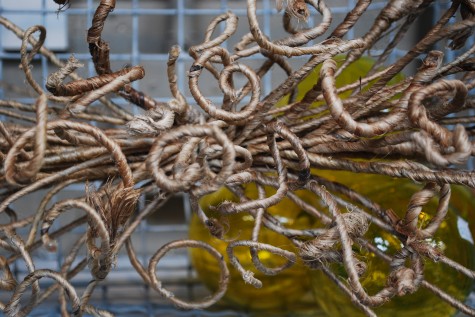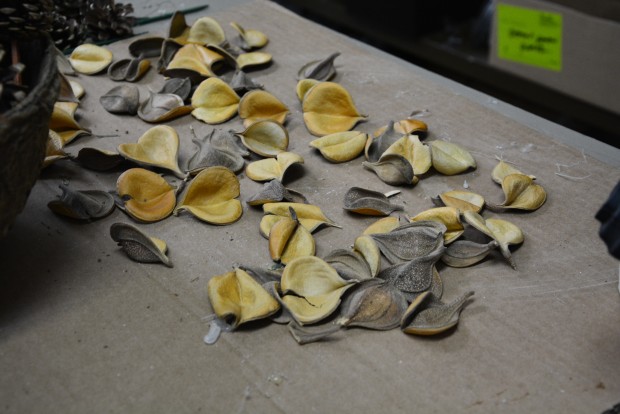 This January, I am spending some time making wreaths. I did not have the time for it in November or December, but late is better than next year. I enjoy all manner of making, whether it be a garden, a garland, a flower arrangement, a container planting, a drawing of a landscape design, or the building a moss topiary sculpture. There is a lot of personal satisfaction in what I can make with my hands. Two hands driven by what I call reverie are hands at work-this I like. A call for all hands on deck is routine for me, in the spring, summer, fall, and early winter. During the gardening season I need help. Hands on can be an adjective, but for me it is a way of professional life. Making wreaths in January does not involve gear, dirt, shovels, weather or others. I can be on my own. I can make them wearing my slippers. I can walk away when I want, and resume when I feel like it. I asked Sunne when the shop was due to close January 9 if she would please leave all of the grapevine, magnolia, and honeysuckle wreath forms, and all of our natural materials on the ground floor. All of what we had left from the fall and winter season is packed away on the tool room roof, but I have 25 square feet of materials not far from my layout table. I am delighted with this arrangement.
This January, I am spending some time making wreaths. I did not have the time for it in November or December, but late is better than next year. I enjoy all manner of making, whether it be a garden, a garland, a flower arrangement, a container planting, a drawing of a landscape design, or the building a moss topiary sculpture. There is a lot of personal satisfaction in what I can make with my hands. Two hands driven by what I call reverie are hands at work-this I like. A call for all hands on deck is routine for me, in the spring, summer, fall, and early winter. During the gardening season I need help. Hands on can be an adjective, but for me it is a way of professional life. Making wreaths in January does not involve gear, dirt, shovels, weather or others. I can be on my own. I can make them wearing my slippers. I can walk away when I want, and resume when I feel like it. I asked Sunne when the shop was due to close January 9 if she would please leave all of the grapevine, magnolia, and honeysuckle wreath forms, and all of our natural materials on the ground floor. All of what we had left from the fall and winter season is packed away on the tool room roof, but I have 25 square feet of materials not far from my layout table. I am delighted with this arrangement.
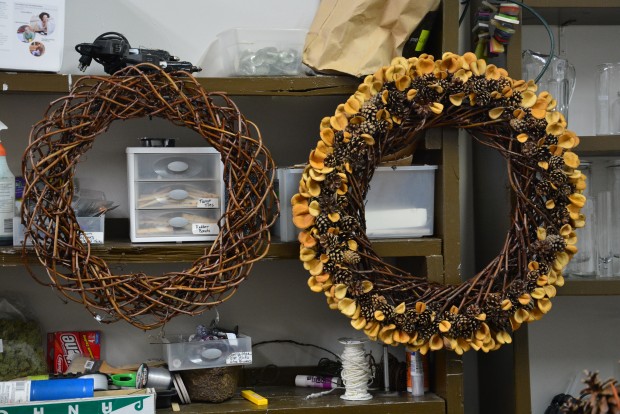 A wreath requires an armature. I do not make these grapevine wreaths, I buy them. Though they are handmade, they are remarkably similar, one wreath to the next. There are those places where this plain hand made grapevine wreath would be perfectly stunning. But they could be just as beautiful as the beginning of something else. Tinkering involves a span of time, and a pair of hands in concert with a point of view.
A wreath requires an armature. I do not make these grapevine wreaths, I buy them. Though they are handmade, they are remarkably similar, one wreath to the next. There are those places where this plain hand made grapevine wreath would be perfectly stunning. But they could be just as beautiful as the beginning of something else. Tinkering involves a span of time, and a pair of hands in concert with a point of view.
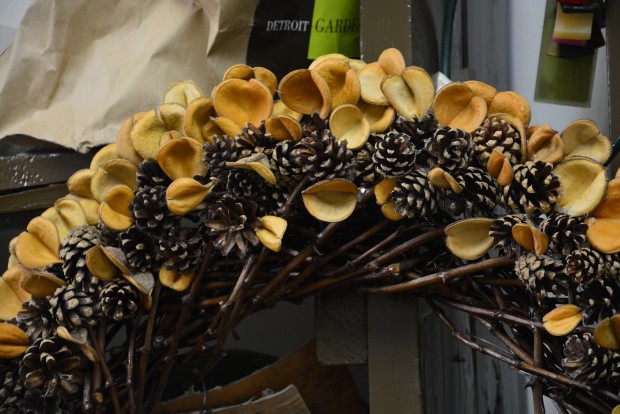 Why be personal? I doubt I truly need to address this in any detail. Any personal expression is genuine. Any genuine expression is to be at least respected, if not admired.
Why be personal? I doubt I truly need to address this in any detail. Any personal expression is genuine. Any genuine expression is to be at least respected, if not admired.
 I have always strongly subscribed to the notion that one can find interesting and noteworthy examples of personal expression anywhere and everywhere. But that aside, the best part of making something is the making. It is absorbing and satisfying. That someone else might like or appreciate it is not the cake part of this. That would be the icing part. Cake with no icing tastes just as good as cake with icing.
I have always strongly subscribed to the notion that one can find interesting and noteworthy examples of personal expression anywhere and everywhere. But that aside, the best part of making something is the making. It is absorbing and satisfying. That someone else might like or appreciate it is not the cake part of this. That would be the icing part. Cake with no icing tastes just as good as cake with icing.
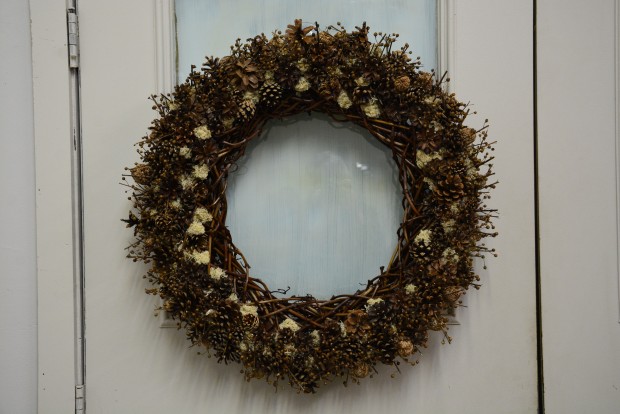
January is the perfect time to make something that takes a long time to fuss over. As a gardener, it always seems like the winter stretches out in front of with, with no end in sight. It’s good to have a project that benefits from having a lot of time for the making.
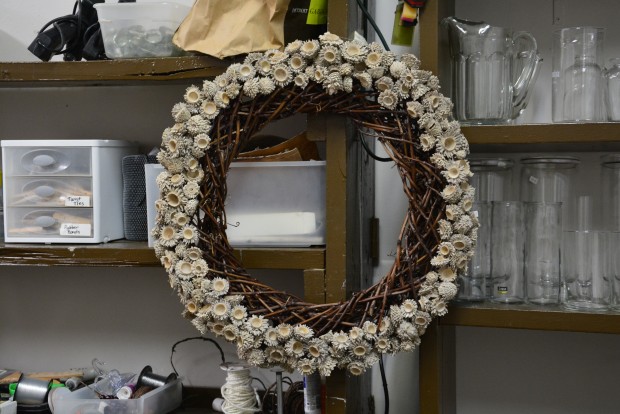 A landscape design that looks rushed on paper will look even more rushed once it is implemented. A request for design during the garden season doesn’t always come with the luxury of a lot of time. A shorter amount of time means a need for a greater amount amount of focus and discipline. January offers the opportunity to be less focused on the end result, and more focused on the pleasure of the process. I welcome the reverie time.
A landscape design that looks rushed on paper will look even more rushed once it is implemented. A request for design during the garden season doesn’t always come with the luxury of a lot of time. A shorter amount of time means a need for a greater amount amount of focus and discipline. January offers the opportunity to be less focused on the end result, and more focused on the pleasure of the process. I welcome the reverie time.
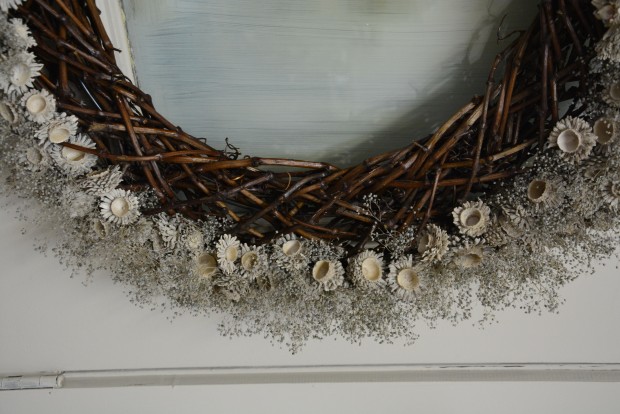 a layer of preserved gypsophila
a layer of preserved gypsophila
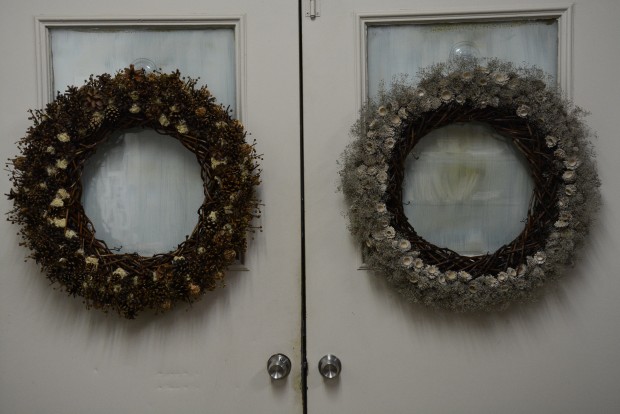 I am not sure if either of these are finished, as I don’t have to be sure. I have them hanging where I can continue to look at them. Maybe something else will occur to me.
I am not sure if either of these are finished, as I don’t have to be sure. I have them hanging where I can continue to look at them. Maybe something else will occur to me.
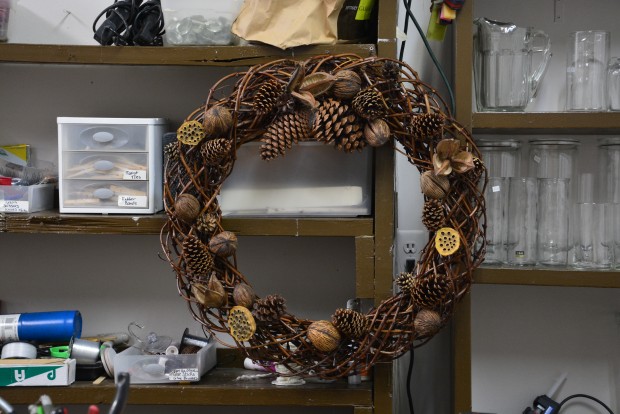 This is the wreath I am working on now. A few days ago, I removed the pair of split pinecones in the top center. That took a fair amount of time, and they were both wired and glued in. But I had the time. It occurred to me that the cut surface of the pine cones would be more interesting than the intact surface. So I took that time.
This is the wreath I am working on now. A few days ago, I removed the pair of split pinecones in the top center. That took a fair amount of time, and they were both wired and glued in. But I had the time. It occurred to me that the cut surface of the pine cones would be more interesting than the intact surface. So I took that time.
 My winter holiday comes after the holiday.
My winter holiday comes after the holiday.
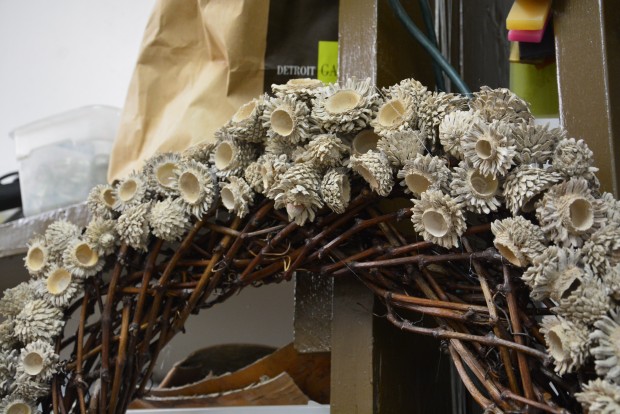

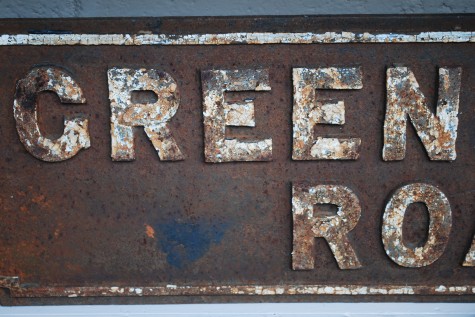
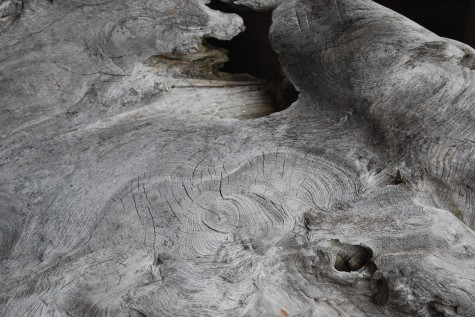
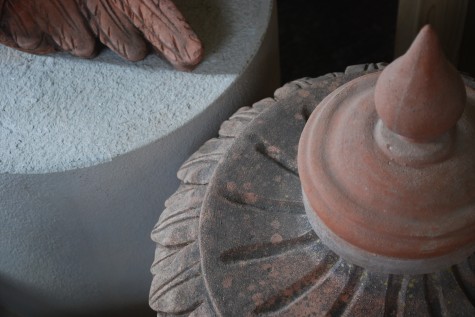
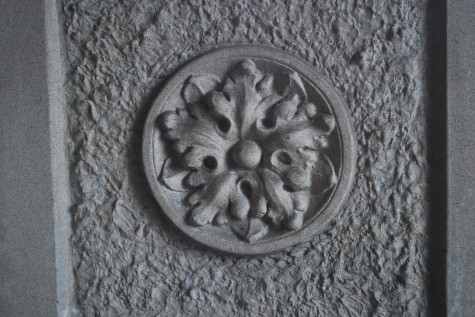 Pictured above is a panel of a terra cotta square pot made by the Galloway Company from Philadelphia Pennsylvania in the early 20th century. The river bottom clay from whence their pots were made is naturally this color. There is no mistaking this is a natural material, even if you have never seen anything made from cream colored clay. The surface is genuine; it rings right.
Pictured above is a panel of a terra cotta square pot made by the Galloway Company from Philadelphia Pennsylvania in the early 20th century. The river bottom clay from whence their pots were made is naturally this color. There is no mistaking this is a natural material, even if you have never seen anything made from cream colored clay. The surface is genuine; it rings right. Do you even have a number in mind for all the different kinds of leaves that must exist? Their surfaces can be hairy, shiny, matte, smooth-there is no end of variation. But what they all have in common are surfaces that are unmistakeably alive. They live and breathe. I could not really explain what it is about a living surface that is so evident. Suffice it to say that I have yet to see an imitation that was truly convincing.
Do you even have a number in mind for all the different kinds of leaves that must exist? Their surfaces can be hairy, shiny, matte, smooth-there is no end of variation. But what they all have in common are surfaces that are unmistakeably alive. They live and breathe. I could not really explain what it is about a living surface that is so evident. Suffice it to say that I have yet to see an imitation that was truly convincing.  Concrete is a man made material which I greatly like. These terra cotta oyster floats have blobs of concrete which help to weigh the floats down in the water. Concrete as a material is at its most beautiful when its surface accurately represents exactly what it is-concrete. Of course everyone has had to make concessions of one kind or another over their garden. I myself have concrete terra cotta pots made in the style of classical Italian terra cotta. I have three places where I wanted a pot in situ 12 months of the year. My concrete pots enable this. Their workmanship is incredibly good. However nothing moves me more than the clay.
Concrete is a man made material which I greatly like. These terra cotta oyster floats have blobs of concrete which help to weigh the floats down in the water. Concrete as a material is at its most beautiful when its surface accurately represents exactly what it is-concrete. Of course everyone has had to make concessions of one kind or another over their garden. I myself have concrete terra cotta pots made in the style of classical Italian terra cotta. I have three places where I wanted a pot in situ 12 months of the year. My concrete pots enable this. Their workmanship is incredibly good. However nothing moves me more than the clay.  Steel and iron are likewise a product of human technology. The surface of steel will age, as it corrodes. The pits in the surface can provide a home for small plants, just like terra cotta. How steel ages can be very beautiful; age on a man made surface greatly enhances its appearance.
Steel and iron are likewise a product of human technology. The surface of steel will age, as it corrodes. The pits in the surface can provide a home for small plants, just like terra cotta. How steel ages can be very beautiful; age on a man made surface greatly enhances its appearance.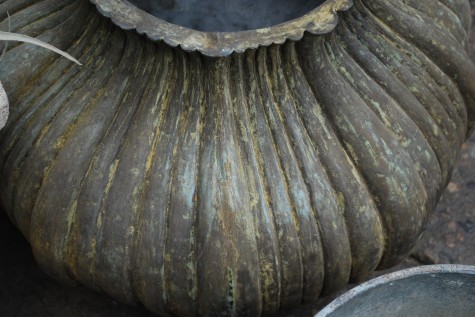 The surface of this terra cotta pot looks like a painting. I have no idea how it was done, but there is no evidence of paint. Whatever altered the surface has soaked in, and become part of the clay. I am told the material is mineral based-as are many pigments.This treatment I can live with. The shape and texture of this pot is beautiful as well-it reminds me of a squash, without trying to look like a squash.
The surface of this terra cotta pot looks like a painting. I have no idea how it was done, but there is no evidence of paint. Whatever altered the surface has soaked in, and become part of the clay. I am told the material is mineral based-as are many pigments.This treatment I can live with. The shape and texture of this pot is beautiful as well-it reminds me of a squash, without trying to look like a squash.